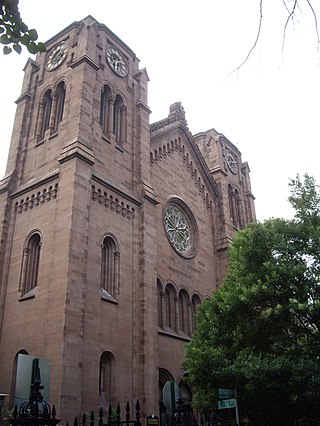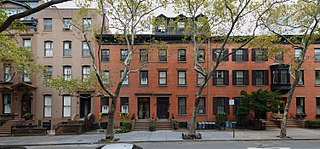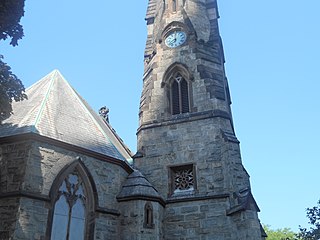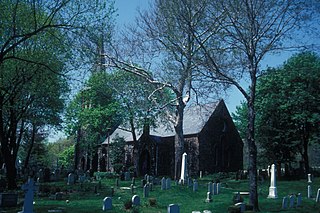
Grace Church is a historic parish church in Manhattan, New York City which is part of the Episcopal Diocese of New York. The church is located at 800–804 Broadway, at the corner of East 10th Street, where Broadway bends to the south-southeast, bringing it in alignment with the avenues in Manhattan's grid. Grace Church School and the church houses—which are now used by the school—are located to the east at 86–98 Fourth Avenue between East 10th and 12th Streets. In 2021, it reported 1,038 members, average attendance of 212, and $1,034,712 in plate and pledge income.

St. Mark's Church in-the-Bowery is a parish of the Episcopal Church located at 131 East 10th Street, at the intersection of Stuyvesant Street and Second Avenue in the East Village neighborhood of Manhattan in New York City. The property has been the site of continuous Christian worship since the mid-17th century, making it New York City's oldest site of continuous religious practice. The structure is the second-oldest church building in Manhattan.

St. Michael's Church is a historic Episcopal church at 225 West 99th Street and Amsterdam Avenue on Manhattan's Upper West Side in New York City. The parish was founded on the present site in January 1807, at that time in the rural Bloomingdale District. The present limestone Romanesque building, the third on the site, was built in 1890–91 to designs by Robert W. Gibson and added to the National Register of Historic Places in 1996.

St. George's Episcopal Church is a historic church located at 209 East 16th Street at Rutherford Place, on Stuyvesant Square in Manhattan, New York City. Called "one of the first and most significant examples of Early Romanesque Revival church architecture in America", the church exterior was designed by Charles Otto Blesch and the interior by Leopold Eidlitz. It is one of the two sanctuaries of the Calvary-St. George's Parish.

The Brooklyn Heights Historic District is a historic district that comprises much of the Brooklyn Heights neighborhood of Brooklyn, New York City. It was named a National Historic Landmark in January, 1965, designated a New York City Landmark in November, 1965, and added to the National Register of Historic Places in October, 1966.

Trinity-St. Paul's Episcopal Church in New Rochelle in Westchester County, New York was added to the National Register of Historic Places in 2006. It is located at the northwest corner of Huguenot Street and Division Street. This church represents the body of the majority group of New Rochelle's founding Huguenot French Calvinistic congregation that conformed to the liturgy of the established Church of England in June 1709. King George III gave Trinity its first charter in 1762. After the American Revolutionary War, Trinity became a parish of the Protestant Episcopal Church of America.

Christ Church — known also as Christ Church, Washington Parish or Christ Church on Capitol Hill — is a historic Episcopal church located at 620 G Street SE in Washington, D.C., USA. The church is also called Christ Church, Navy Yard, because of its proximity to the Washington Navy Yard and the nearby U.S. Marine Barracks.

St. Monica's Church is a historic former Roman Catholic parish church in the Diocese of Brooklyn, located in Jamaica, Queens, New York. It was built in 1856 and is a brick basilica-type building in the Romanesque style. It features a four-story entrance tower in the center of its three-bay-wide front facade. Saint Monica's Church has been refurbished on the Campus of York College as a child care center.

The New York Landmarks Conservancy is a non-profit organization "dedicated to preserving, revitalizing, and reusing" historic structures in New York state. It provides technical and financial skills to owners of historic properties. In the half century since its 1973 founding, the conservancy has provided more than $60 million in grants and loans.

Grace Episcopal Church is the second oldest Episcopal congregation in Chicago, Illinois, United States. Since December 1985 it has occupied its 6th location, in a former printing works located at 637 South Dearborn Street in the Printer's Row neighborhood. Now also called Grace Place, the historic 3-story redbrick late 19th century Arts and Crafts building is a contributing property in the South Dearborn Street-Printing House Row North Historic District. Grace Place is also listed in the City of Chicago's Chicago Landmarks Historic Resources Survey.

St. George's Church is an intercultural, multilingual Episcopal congregation in Flushing, Queens, New York City. With members from over twenty different nations of origin, it has served an ever-changing congregation since the 18th century. The current church building, constructed in 1854, is a New York City designated landmark on the National Register of Historic Places.

St. James Church is a historic Episcopal church building at 86-02 Broadway in the Elmhurst neighborhood of Queens in New York City. It is the city's oldest surviving Anglican building and Church of England mission church. It is also alternatively called the Old St. James Church to distinguish it from the St. James Episcopal Church two blocks away.

The Church of St. Andrew is a historic Episcopal church located at Arthur Kill and Old Mill Roads on the north side of Richmondtown in Staten Island, New York.

St. Philip's Episcopal Church is a historic Episcopal church located at 204 West 134th Street, between Adam Clayton Powell Jr. Boulevard and Frederick Douglass Boulevard in the Harlem neighborhood of Manhattan, New York City. Its congregation was founded in 1809 by free African Americans worshiping at Trinity Church, Wall Street as the Free African Church of St. Philip. First located in the notorious Five Points neighborhood, it is the oldest black Episcopal parish in New York City. Historically, it was extremely influential both while located in lower Manhattan and as an institution in Harlem, and many of its members have been leaders in the black community. In 2020, it reported 188 members, 111 average attendance, and plate and pledge income of $224,827.

Christ Church Riverdale is a historic Episcopal parish church and related structures at 5040 Henry Hudson Parkway East in Riverdale, Bronx, New York City.

The Jamaica Savings Bank was a bank incorporated in 1866 in the Jamaica section of the borough of Queens in New York City. It had four branches across Queens before it was acquired by North Fork Bank in 1999, which itself was acquired by Capital One Bank in 2008.

Prospect Cemetery is a historic cemetery located in the Jamaica section of the New York City borough of Queens. It was established in 1668 and known as the "burring plas." The cemetery's original main gate was on Beaver Road which led from Sutphin Boulevard to Jamaica Avenue. The cemetery was generally known as the Presbyterian burial ground and is one of the few remaining Colonial cemeteries in Queens.

Calvary Church is an Episcopal church located at 277 Park Avenue South on the corner of East 21st Street in the Gramercy Park neighborhood of Manhattan, New York City, on the border of the Flatiron District. It was designed by James Renwick Jr., the architect who designed St. Patrick's Cathedral and Grace Church, and was completed in 1848. The church complex is located within the Gramercy Park Historic District and Extension. It is one of the two sanctuaries of the Calvary-St. George's Parish.

The Jamaica Savings Bank is a building at Jamaica Avenue and Sutphin Boulevard in Jamaica, Queens, New York City. The building was built between 1938 and 1939 in the Art Deco style. It replaced the Queensboro Savings Bank at 90-55 Sutphin Boulevard, which was acquired by the Jamaica Savings Bank in 1934 and demolished in 1938. The address was changed to the current 146-21 Jamaica Avenue and is a New York City designated landmark.

























